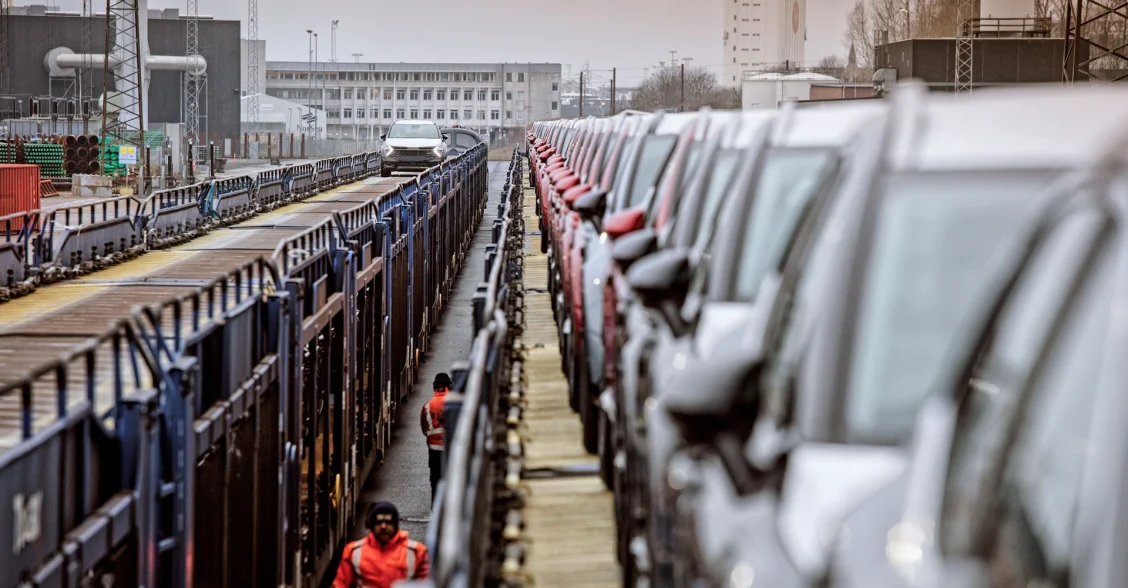A new direct train service between Slovakia and Port Esbjerg is expected to transport 10,000 new cars to Esbjerg on an annual basis. These cars will be reloaded at the port and shipped to the UK. The first delivery went “almost perfectly”, says Scandinavian Auto Logistics, which handles the cars at the port. “This is merely stage one,” says the CEO of Port Esbjerg.
“It went almost perfectly,” says Esben Lund Mørk, Port & Multiterminal Manager at Scandinavian Auto Logistics, commenting on the initial delivery of 240 cars that arrived by train directly from Slovakia to Port Esbjerg. They were unloaded from the train at the port with the use of a newly built and specially designed ramp and then prepared for their onward journey with DFDS to Immingham in the UK.
This was merely the first of many transports. The plan is for a train to arrive with a similar cargo regularly every week, meaning that more than 10,000 cars will be transported through this new logistics corridor on an annual basis.
“We’re seeing an increase in RoRo transport at the port, and this collaboration is a clear example of the opportunities created by the extension of the railway tracks at the port. This is the first of many stages,” says Dennis Jul Pedersen, CEO of Port Esbjerg.
Rail transport is not only easier – compared to reloading the cars onto trucks and heading north – it is also greener.
Tracks extending the route down through Europe
The new train service also allows for efficient return transport of vehicles from, for example, the UK via Denmark and to the rest of Europe. This ensures an optimised supply chain in both directions.
Last year’s extension of the railway tracks to the port area facilitated land-based rail transport of cars. The railway was extended by 800 metres over two tracks. Also, the recent deepening of the fairway means that the port now accommodates larger vessels, which further strengthens connections across Europe and the North Sea to the rest of the world.
“This illustrates perfectly how investments in infrastructure and technology will drive innovation and create new business opportunities for the port’s customers. We are better equipped than ever to support RoRo and reinforce our role as a central hub for infrastructure and logistics. We hope and trust that businesses in Romania, the Czech Republic and other Eastern European countries will be able to take advantage of this opportunity in the future,” says Jul Pedersen.
The ramp is an own innovation
Scandinavian Auto Logistics prepared the initial rail transport very carefully and, in a joint effort with local supplier Toftlund Maskinfabrik, the company spent a year developing the ramp used to unload the cars from the train. The first car was unloaded at 10.00 and the last car drove over the ramp at 13.30.
“The ramp worked like a dream. It was a brilliant experience,” says Mørk.
The ramp is mobile, so it may be placed at either end of the train, and the hydraulics allow it to be raised and lowered to both the upper and lower decks.
“It’s pretty cool,” as Mørk puts it.
“There are many car factories in Eastern Europe, Sweden, etc., so the potential is huge. The game has completely changed, and the sky’s the limit,” he says.
When the cars are loaded onto the DFDS vessels, they are packed very close, side mirror to side mirror, with just a little over 30 cm between bumpers, and are then secured on deck with rubber wheel chocks.
In 2024, 1.9 million new passenger cars were sold in the UK, so Mørk also believes that this is merely the beginning.
For DFDS, the route is also a game changer. DFDS has daily departures from Esbjerg to the UK, and up until 2023 they have had unused hoistable decks with room for passenger cars, so the capacity of the vessels is now used more efficiently. DFDS already transports cars that cannot be loaded in Cuxhaven due to capacity shortage there. They have had to be transported to Esbjerg by truck.
Now resources will be better utilised. DFDS expects to ship some 13,000–14,500 passenger cars annually from Esbjerg, compared with 3,500 in 2023, Sanne Thomsen, Route Director at DFDS, explains.
“We’re very pleased with the success of this project. We are contributing to putting Esbjerg on the map in a new context while at the same time filling our vessels more efficiently,” she says.
Go to overview

